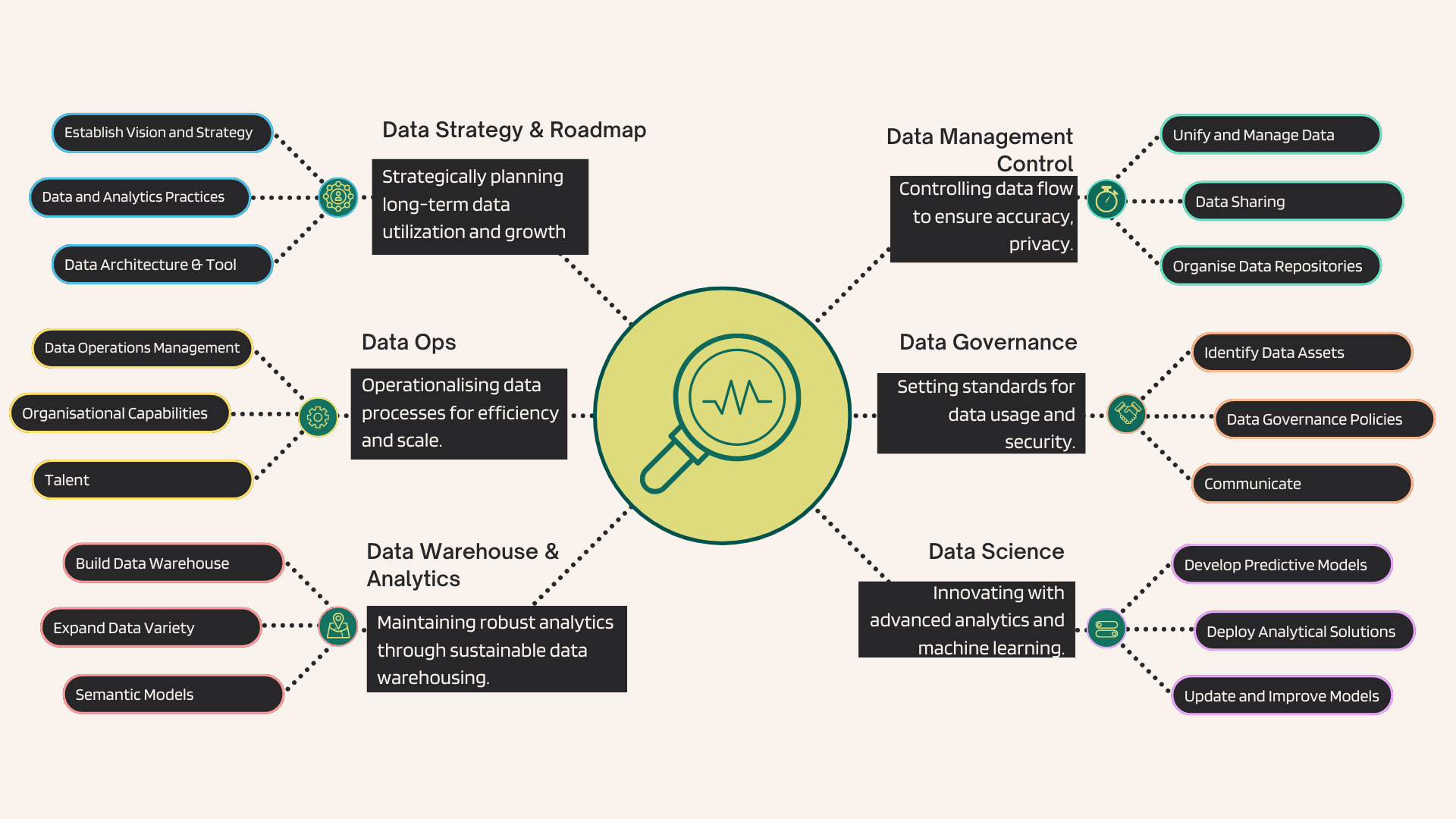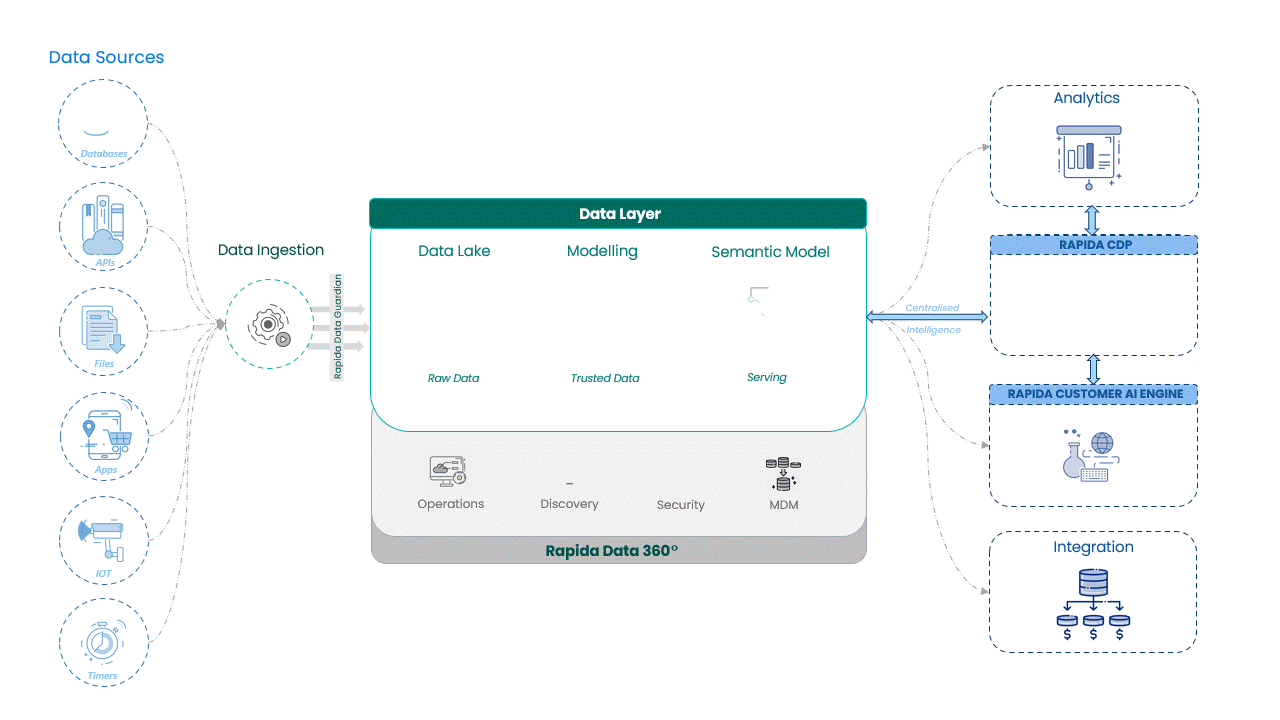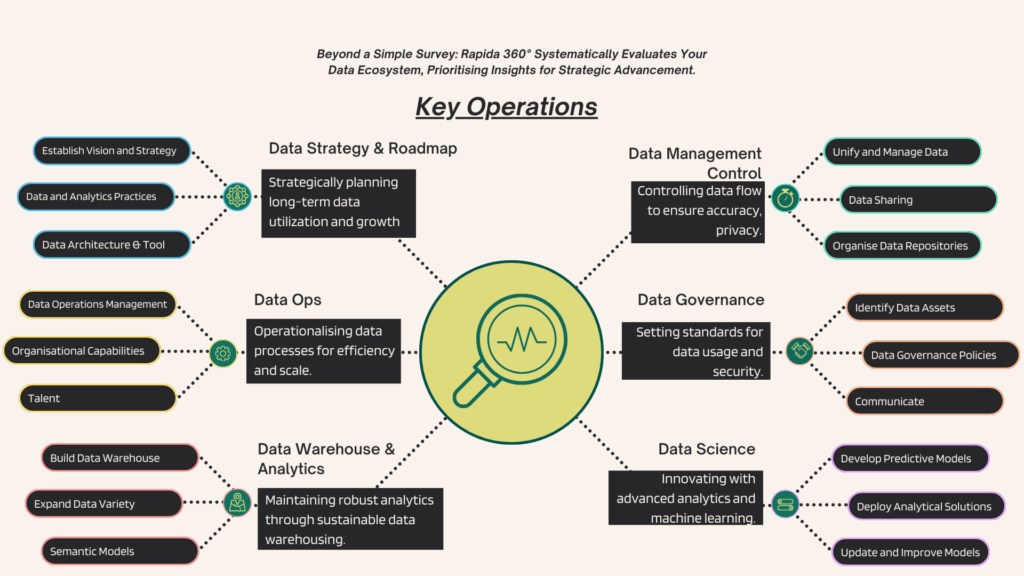Fuelling business growth through strategic data solutions and partnerships.

Artificial Intelligence (AI) is reshaping industries, enabling businesses to make smarter decisions, automate processes, and uncover new opportunities. However, many organizations rush into AI initiatives without addressing a critical prerequisite: a solid data strategy. Without properly governed, organized, and high-quality data, even the most advanced AI systems will fail to deliver reliable results.
At Rapida Solutions, we emphasize that successful AI begins with a well-thought-out data strategy. This involves aligning governance, architecture, and processes with business goals before advancing to techniques like data modeling and quality monitoring. Let’s explore why this approach is essential and how it sets the stage for AI success.
A robust data strategy ensures that your data is not only collected but also managed and maintained in a way that supports both current operations and future AI initiatives. According to AWS, a data strategy is a long-term plan that defines the technology, processes, people, and rules required to manage an organization’s information assets effectively.
Here are the key components of a successful data strategy:
1. Data Governance: Establish policies and controls to ensure consistent management of data across the organization. This includes defining roles for data ownership, ensuring compliance with regulations (e.g., GDPR), and setting standards for secure access and usage.
2. Data Architecture: Design scalable systems such as data warehouses or lakes that integrate structured and unstructured data from multiple sources. A well-designed architecture ensures seamless data flow and accessibility.
3. Data Management: Implement processes for collecting, storing, transforming, and maintaining your data throughout its lifecycle. Effective management reduces redundancy and ensures datasets remain relevant.
4. Data Quality: Continuously monitor for duplicates, missing values, outdated records, or inconsistencies. Poor-quality data can undermine AI performance. Research shows that 80% of an AI project’s effort often goes into preparing and cleaning data. Tools like Rapida Data Guardian automate checks to maintain accuracy over time.
5. Data Controls and Security: Protect sensitive information by implementing robust access controls and security protocols. This ensures compliance with regulations while safeguarding against breaches or misuse.
6. Scalability: Ensure your infrastructure can handle growing volumes of data as your business expands or adopts more complex AI use cases. Scalability prevents bottlenecks as demands increase.
7. Data Accessibility: Provide stakeholders with intuitive tools for exploring insights without relying on IT support. Self-service analytics empower teams to make faster decisions based on real-time data.
8. Data Literacy: Foster a culture where employees understand the value of data and are equipped to interpret it effectively. This ensures that insights derived from AI are actionable across all levels of the organization.
Once foundational elements are in place, organizing your data into usable structures becomes critical, and this is where data modeling, particularly dimensional modeling, plays a key role.
Dimensional modeling organizes your data into:
*Facts: Quantifiable metrics like sales revenue or website visits.
*Dimensions: Categories like time, location, product type, or customer demographics.
This structure makes it easier to analyze trends, identify patterns, and generate actionable insights, whether through traditional reporting tools or advanced AI algorithms.
For example:
*A retailer can use dimensional modeling to analyze sales trends by region during specific time periods to predict demand.
*A logistics team can optimize delivery routes by structuring historical traffic patterns into dimensions like geography and time of day.
A study by SQLDBM highlights that well-designed models reduce the time spent cleaning and organizing data by up to 40%, allowing teams to focus on refining AI algorithms instead(2).

From raw data to AI-ready insights: Data flows through ingestion, quality checks with Rapida Data Guardian, transformation in the Rapida Data Layer, and powers tools, integrations, CDPs, analytics, and AI.
Even with proper governance and modeling in place, maintaining high-quality data is an ongoing challenge. Issues such as duplicate records or outdated information can degrade system performance over time.
According to research by AIMultiple, poor-quality data leads directly to inaccurate predictions, flawed decision-making, and diminished trust in AI systems(4). Continuous monitoring is essential to catch anomalies early and maintain reliability.
At Rapida Solutions, our Rapida Data Guardian automates quality checks across datasets to ensure they remain accurate over time. It identifies anomalies in real-time so teams can resolve issues before they impact decision-making or AI performance.
The concept of “garbage in, garbage out” (GIGO) remains a stark reminder of why robust data strategies are essential for AI success. If input data is disorganized or low-quality, outputs will be flawed, leading to poor decisions that waste resources or harm your business.
One particularly concerning outcome of poor data quality and data strategy is AI hallucination, a phenomenon where AI systems generate outputs that appear plausible but are factually incorrect or nonsensical. Hallucinations often occur when AI models are trained on incomplete, biased, or inconsistent datasets. For example, an AI system tasked with analyzing customer sentiment might fabricate trends or insights if the underlying data is riddled with gaps or inaccuracies.
These hallucinations can undermine trust in AI systems, especially in critical applications like healthcare, finance, or decision-making processes. The root cause often lies in the “garbage” fed into these systems—data that lacks accuracy, completeness, or proper structure.
On the other hand:
* With proper governance in place, you ensure compliance while protecting sensitive information.
*With dimensional modeling applied effectively, you enable faster insights from well-organized datasets.
*With continuous quality monitoring tools like Rapida Data Guardian, you maintain trust in your analytics over time.
By investing in a comprehensive data strategy upfront, you create a foundation that supports not just AI but all aspects of decision-making within your organization.
At Rapida Solutions, we specialize in helping businesses transform chaotic datasets into structured assets ready for AI-driven innovation.
Here’s how we can support you:
*The Rapida Data Layer: Simplifies dimensional modeling with pre-built semantic models tailored to your industry’s needs.
*Unified Data Hub: Consolidates siloed datasets into a single source of truth for consistent analysis.
*Rapida Data Guardian: Automates quality checks to ensure continuous reliability.
*Data Strategy Assessment (Rapida 360o): We offer comprehensive evaluations of your current data landscape to identify gaps and opportunities for improvement.

Our assessments cover all key areas, governance, architecture, quality monitoring, and provide actionable recommendations tailored to your business goals.
AI success doesn’t start with algorithms; it starts with data, and more importantly, with a solid strategy for managing it effectively. At Rapida Solutions, we help businesses take control of their data so they can unlock the full potential of AI while improving decision-making across their organization.
Contact us today to learn more about our services, or let us help you assess where you stand on your journey toward an effective data strategy.
